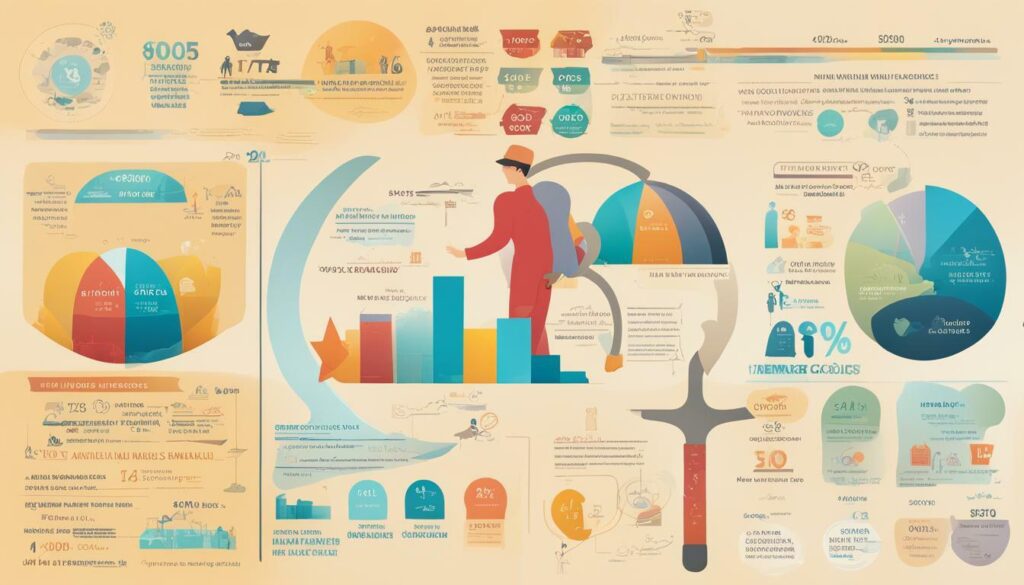Life insurance is a smart investment to protect your loved ones financially in the event of your unexpected death. However, one of the most common questions people have is, “How much is life insurance per month?” The answer depends on several factors, including your age, health, coverage amount, and the type of policy you choose. Let’s dive into the details so you can better understand how life insurance premiums are calculated.
Key Takeaways:
- The cost of life insurance per month is based on various factors such as age, health, coverage amount, and policy type.
- Understanding the factors that influence life insurance premiums can help you set a budget and make an informed decision about your coverage needs.
- Using a life insurance cost calculator can provide you with an estimate of your monthly premium.
- There are strategies for finding affordable life insurance policies that fit within your budget.
Factors that Influence Life Insurance Cost
When it comes to life insurance pricing, there are several factors to consider that can impact the cost of your policy. Understanding these factors will help you make informed decisions about your coverage and budget.
| Factor | Description |
|---|---|
| Age | Age is a major factor in determining life insurance rates. Generally, the younger you are, the lower your rates will be, as you are considered less of a risk to insure. |
| Health | Your overall health and medical history can also influence your life insurance rates. Insurers will consider factors such as pre-existing conditions, smoking status, and family medical history. |
| Coverage Amount | The amount of coverage you need will impact your premiums. Generally speaking, the higher the coverage amount, the higher the monthly cost. |
| Policy Type | The type of life insurance policy you choose can also affect your rates. Term life insurance is typically more affordable than whole or universal life insurance. |
| Gender | While often overlooked, gender can also play a role in life insurance pricing. Women generally have lower rates than men due to longer life expectancies and lower risk of certain health issues. |
| Occupation | Certain occupations may be considered riskier than others, which could impact your life insurance premiums. For example, a commercial pilot may pay higher premiums than an office worker. |
Keep in mind that each insurer may weigh these factors differently, which is why it’s important to compare quotes from multiple companies to find the best rates for your needs.
Determining Your Coverage Needs
When considering life insurance, it’s essential to determine how much coverage you need to protect your loved ones financially. This involves assessing your current financial situation and considering any future expenses and financial goals. By determining your coverage needs, you can make an informed decision about the amount of coverage to purchase and its impact on the monthly cost.
Start by considering income replacement. If you were to pass away, how much income would your family need to maintain their standard of living? A common rule of thumb is to purchase coverage equal to 10-12 times your annual income.
You should also consider any outstanding debts, such as a mortgage or car loan. Your life insurance policy should provide enough coverage to pay off these debts, so your family doesn’t have to assume the burden.
Future expenses, such as college tuition or retirement savings, should also be taken into account. It’s important to ensure your life insurance policy provides enough coverage to cover these costs.
Finally, consider any specific financial goals you have, such as leaving an inheritance for your children or donating to charity. Your life insurance policy can be tailored to meet these goals.


By carefully determining your coverage needs, you can ensure your loved ones are financially protected if something were to happen to you. Keep in mind that the amount of coverage you need will impact the monthly cost of your life insurance policy, so be sure to factor this into your budget.
Types of Life Insurance Policies
When shopping for life insurance, it’s crucial to understand the different types of policies available and their features. The three main types of life insurance policies are term life insurance, whole life insurance, and universal life insurance. Each type has its own advantages and disadvantages, and the right choice will depend on your individual needs and circumstances.
| Type | Features | Benefits |
|---|---|---|
| Term Life Insurance | Provides coverage for a specific period (usually between 10 and 30 years) | Lower premiums, higher coverage amounts, flexibility to adjust coverage as needed |
| Whole Life Insurance | Provides coverage for the entire life of the policyholder | Cash value accumulation, guaranteed death benefit, level premiums |
| Universal Life Insurance | Similar to whole life insurance but with greater flexibility in premiums and death benefit | Cash value accumulation, flexibility in premiums and death benefit, potential to earn higher returns |


Term life insurance is a popular choice for those seeking affordable coverage for a specific period. Premiums are typically lower than other types of life insurance, making it an attractive option for those on a budget. Additionally, coverage amounts can be adjusted as needed to accommodate changing financial needs.
Whole life insurance provides permanent coverage for the entire life of the policyholder. Premiums are typically higher, but the policy accumulates cash value over time that can be borrowed against or used to pay premiums. These policies offer a guaranteed death benefit and level premiums, making it a reliable option for long-term coverage.
Universal life insurance is similar to whole life insurance but offers more flexibility in premiums and death benefit. Policyholders can adjust the premium and death benefit as needed, and the policy accumulates cash value over time. Universal life insurance policies have the potential to earn higher returns, but there is also greater risk involved.
When considering which type of life insurance policy to choose, it’s important to assess your individual needs and preferences. Term life insurance may be the right choice if you’re looking for affordable coverage for a specific period, while whole life insurance or universal life insurance may be better if you’re seeking long-term coverage and potential cash value accumulation.
Term Life Insurance Cost Factors
When it comes to term life insurance, several factors can influence the monthly cost of your policy. The cost factors of term life insurance include:
| Factor | Description |
|---|---|
| Age | Younger individuals are typically offered lower rates due to their lower risk of mortality. |
| Health | Individuals who are in good health can qualify for lower rates because they are considered less risky to insure. |
| Term length | Shorter terms are generally less expensive than longer terms because the insurer is exposed to risk for a shorter period. |
| Coverage amount | A higher policy limit will result in a higher monthly premium. |
| Occupation and hobbies | Individuals who work in high-risk occupations or have hazardous hobbies may need to pay more for their life insurance policy. |
While term life insurance rates are generally lower than permanent policies, it’s important to consider all the factors that may affect your monthly premium. By understanding the cost factors, you can make an informed decision about the coverage amount and term length that meets your needs and budget.
When it comes to term life insurance pricing, the best way to obtain an accurate estimate is to obtain a quote from an insurer. You can also use a life insurance cost calculator to get a rough idea of how much you can expect to pay per month. Keep in mind that these tools are not always 100% accurate and rates can vary based on individual circumstances.


Whole Life Insurance Cost Factors
Whole life insurance policies provide a lifelong coverage with a savings component that accumulates cash value over time. The monthly premium for whole life insurance is generally higher than other types of policies, but it provides a guaranteed death benefit and protection for your entire life. Understanding the cost factors of whole life insurance is important to make an informed decision about this type of policy.
Age: Age is a key factor that influences the cost of whole life insurance. Generally, the younger you are when you purchase the policy, the lower your premiums will be.
Health: Your health plays an important role in determining the cost of your whole life insurance. If you have any pre-existing health conditions or lifestyle factors like smoking that may pose a greater risk to the insurer, your premiums may be higher.
| Cost Factors of Whole Life Insurance | Impact on Premiums |
|---|---|
| Coverage Amount | A higher coverage amount will result in higher premiums. |
| Cash Value Accumulation | Whole life insurance policies accumulate cash value over time, which can impact your premiums. Higher cash value accumulation results in higher premiums. |
| Dividends | Some whole life insurance policies pay dividends to policyholders, which can offset the cost of premiums. |
Coverage Amount: The coverage amount you choose for your whole life insurance policy will also impact the monthly premium. If you opt for a higher coverage amount, your premiums will likely be higher.
Cash Value Accumulation: Cash value accumulation is a unique feature of whole life insurance policies. As you pay your premiums, a portion of your payment goes into a savings or investment account that accrues interest. The cash value accumulation in your policy can impact your premiums. Generally, the higher the cash value accumulation, the higher the premiums.
Dividends: Some whole life insurance policies pay dividends to policyholders based on the performance of the insurer’s investments. These dividends can be used to offset the cost of premiums.
By understanding the cost factors of whole life insurance, you can make an informed decision about whether this type of policy is right for you. Consider your individual needs and budget to determine if the benefits of whole life insurance outweigh the higher cost.


Universal Life Insurance Cost Factors
If you’re considering universal life insurance, it’s important to understand how its various cost factors affect your monthly premiums. One of the key factors that impact the cost of universal life insurance is the death benefit. This is the amount paid out to your beneficiaries in the event of your death. As a general rule, the higher the death benefit, the higher your monthly premiums will be.
Another important factor in determining the cost of universal life insurance is cash value accumulation. Universal life insurance policies offer a cash value component that can grow over time, but this can also impact your premiums. The more cash value your policy has, the higher your premiums may be.
Interest rates can also play a role in determining the cost of universal life insurance. Higher interest rates may lead to lower premiums, while lower interest rates can increase premiums.
| Cost Factors | Impact on Universal Life Insurance Rates |
|---|---|
| Death Benefit | Higher death benefit leads to higher premiums |
| Cash Value Accumulation | Higher cash value accumulation can increase premiums |
| Interest Rates | Lower interest rates may lead to higher premiums |
It’s important to work with a reputable insurance agent or broker to determine the right coverage amount and policy type for your unique needs. By taking your individual circumstances into account, you can find a universal life insurance policy that fits your budget and provides the protection you need.


Average Cost of Life Insurance
If you’re considering buying life insurance, you’re probably wondering how much it will cost. The answer, of course, depends on a variety of factors, including your age, health, and the amount of coverage you need.
According to a study conducted by the National Association of Insurance Commissioners (NAIC), the average cost of a life insurance policy is around $44 per month. However, this figure can vary widely depending on individual circumstances.
For example, if you’re young and healthy, you can expect to pay lower premiums than someone who is older and has health issues. Similarly, if you’re looking for a high amount of coverage, your monthly premiums will be higher than someone who only needs a small policy.
To give you a better idea of what to expect, here are some average life insurance premiums broken down by age and coverage amount:
| Age | Coverage Amount | Average Monthly Premium |
|---|---|---|
| 25 | $250,000 | $15 |
| 35 | $500,000 | $24 |
| 45 | $750,000 | $54 |
| 55 | $1,000,000 | $109 |
Keep in mind that these figures are just averages, and individual rates will vary depending on a variety of factors.
To get a more accurate estimate of how much life insurance will cost for you, it’s a good idea to use a life insurance cost calculator. By inputting your age, health, and coverage needs, you can get an idea of what your monthly premiums might be.


Remember, life insurance is an important investment in your family’s future. While it’s important to find an affordable policy that fits your budget, it’s also important to ensure that you have adequate coverage in case something unexpected happens.
Utilizing a Life Insurance Cost Calculator
Calculating life insurance cost can be a complex process, especially when multiple factors come into play. That’s where life insurance cost calculators come in handy.
These tools allow you to input your data and instantly get an estimate of how much your life insurance policy will cost per month. Factors such as age, health, and coverage amount are taken into account, giving you an accurate idea of what to expect.
Using a life insurance cost calculator is not only convenient but also saves you time and effort. Instead of manually calculating the costs, you can get an estimate instantly.
One benefit of using a life insurance cost calculator is that it helps you set a budget for your policy. By inputting different coverage amounts and term lengths, you can see how they affect the monthly premium. This allows you to make an informed decision about the coverage amount that fits within your budget.
| Benefits of using a life insurance cost calculator: |
|---|
| Convenience: Get an instant estimate of your life insurance policy cost. |
| Accuracy: Accurately calculate the costs based on your specific information. |
| Budgeting: Set a realistic budget for your life insurance policy based on different coverage amounts and term lengths. |


Overall, utilizing a life insurance cost calculator is an effective way to get an estimate of your policy’s cost, allowing you to make an informed decision about your life insurance coverage.
Finding Affordable Life Insurance
Life insurance is an important investment to protect your loved ones, but it can often come with a high price tag. However, there are ways to find affordable life insurance that fits within your budget. Here are some tips to get you started:
1. Determine Your Coverage Needs
Before you start shopping for life insurance, it’s important to determine the right amount of coverage you need. This will help you avoid overpaying for unnecessary coverage. Consider factors such as income replacement, debt coverage, future expenses, and any specific financial goals you may have.
2. Improve Your Health
One of the key factors that can impact the cost of life insurance is your health. Insurers typically offer lower rates to those who are in good health. By making healthy lifestyle choices, you may be able to improve your overall health and secure lower life insurance premiums.
3. Compare Quotes
Shopping around for the best rates is crucial to finding affordable life insurance. Use online quote comparison tools to compare rates from multiple insurers. Keep in mind that the lowest rate may not always be the best option, so be sure to consider the insurer’s reputation and financial stability as well.
4. Choose Term Life Insurance
Term life insurance is typically the most affordable type of life insurance. This type of policy provides coverage for a set period, such as 10 or 20 years, and premiums are often lower than other types of policies. Consider whether term life insurance is the right option for your needs.
5. Work with an Independent Agent
An independent insurance agent can help you find the best rates by shopping around with multiple insurers. They can also offer advice on the most affordable types of policies and coverage amounts. Consider working with an independent agent to secure affordable life insurance.
By following these tips, you can find affordable life insurance options that fit within your budget. Don’t let cost prevent you from protecting your loved ones with this important investment.


Understanding Life Insurance Premiums
When you purchase life insurance, you pay a monthly or annual premium to the insurance company. The premium is the cost of your policy, and it is determined by a variety of factors. Understanding these factors is key to knowing how much you will pay for life insurance, and to ensure that you are getting the best possible value for your money.
The primary factor that determines your premium is mortality. Mortality tables are used to estimate the likelihood of your death based on your age, gender, and other factors. The insurer uses this information to determine the amount of risk it is taking on by insuring you, and adjusts your premium accordingly.
Another factor that affects your premium is the cost of providing the insurance. This includes expenses such as marketing, underwriting, and claims processing. Generally, the larger the insurance company, the more efficiently it can provide these services and the lower your premium will be.
Finally, the amount of coverage you have also impacts your premium. The more coverage you have, the higher your premium will be. However, as we discussed earlier, it is important to determine the appropriate level of coverage to meet your needs and provide peace of mind for your loved ones.
Overall, understanding how your life insurance premium is calculated is essential to making informed decisions about your coverage. By working with a reputable insurer and carefully assessing your needs, you can secure the right coverage at a price that fits your budget.


“The premium is the cost of your policy, and it is determined by a variety of factors. Understanding these factors is key to knowing how much you will pay for life insurance…”
Conclusion
Understanding how much is life insurance per month is crucial when planning for your future. By taking into account the factors that influence the cost of life insurance, such as age, health, coverage amount, and type of policy, you can better determine the right coverage for your needs and budget.
Utilizing a life insurance cost calculator can help you estimate the monthly cost of your policy, and finding affordable options can ensure that you are adequately covered without breaking the bank. It’s important to remember that life insurance premiums are calculated based on various factors, including mortality and expense charges.
By taking the time to understand these factors and making informed decisions, you can confidently secure your life insurance coverage. Don’t wait until it’s too late – take action today to protect your future and the future of your loved ones.
How much is life insurance per month?
The answer will depend on your individual needs and circumstances. However, by doing your research and assessing your requirements, you can determine a monthly cost that fits within your budget and provides the necessary coverage for your life insurance policy.
FAQ
Q: How much is life insurance per month?
A: The cost of life insurance per month varies depending on several factors such as age, health, coverage amount, and type of policy. It is best to get personalized quotes from insurance providers to determine the exact cost for your specific situation.
Q: What factors influence the cost of life insurance?
A: The cost of life insurance is influenced by factors such as age, health, coverage amount, type of policy, and lifestyle choices. Younger individuals with good health and smaller coverage amounts generally have lower premiums.
Q: How do I determine the coverage amount I need?
A: To determine your coverage needs, consider factors like income replacement, debt coverage, future expenses, and any specific financial goals. You can also seek guidance from insurance professionals to ensure you have the appropriate amount of coverage.
Q: What are the different types of life insurance policies?
A: There are various types of life insurance policies, including term life insurance, whole life insurance, and universal life insurance. Each type has its own features, benefits, and cost implications.
Q: What are the cost factors for term life insurance?
A: The cost of term life insurance is influenced by factors such as the length of the term, age at the time of policy purchase, health condition, and coverage amount. Generally, term life insurance is more affordable compared to other types of policies.
Q: What are the cost factors for whole life insurance?
A: The cost of whole life insurance is determined by factors such as age, health condition, coverage amount, and the cash value accumulation. Whole life insurance tends to have higher premiums compared to term life insurance.
Q: What are the cost factors for universal life insurance?
A: Cost factors for universal life insurance include the death benefit, cash value growth, premiums, and interest rates. These factors play a role in determining the monthly cost of universal life insurance.
Q: What is the average cost of life insurance?
A: The average cost of life insurance varies based on factors such as age and coverage amount. It is best to obtain personalized quotes from insurance providers to get an accurate idea of the expected cost.
Q: How can I use a life insurance cost calculator?
A: A life insurance cost calculator can help you estimate the monthly cost of your life insurance policy. You input your information regarding age, health, coverage amount, and other relevant details, and the calculator provides an estimate of the cost.
Q: How can I find affordable life insurance?
A: To find affordable life insurance, consider factors such as selecting the right coverage amount, improving your health, and comparing quotes from different insurers. Working with an insurance professional can also help you navigate the options and find a low-cost life insurance policy.
Q: How are life insurance premiums calculated?
A: Life insurance premiums are calculated based on factors such as mortality rates, expenses, and risk factors associated with the insured individual. Insurance companies use actuarial calculations to determine the premiums.







